Evolution of Phase Transformation on Microwave Dielectric Properties of BaSixO1+2x Ceramics and Their Temperature-Stable LTCC Materials
Abstract
:1. Introduction
2. Materials and Methods
3. Results
4. Conclusions
Supplementary Materials
Author Contributions
Funding
Data Availability Statement
Conflicts of Interest
References
- Zhou, D.; Pang, L.X.; Wang, D.W.; Li, C.; Jin, B.B.; Reaney, I.M. High permittivity and low loss microwave dielectrics suitable for 5G resonators and low temperature co-fired ceramic architecture. J. Mater. Chem. C 2017, 5, 10094–10098. [Google Scholar] [CrossRef]
- Wu, F.F.; Zhou, D.; Du, C.; Jin, B.B.; Li, C.; Qi, Z.M. Design of a Sub-6 GHz dielectric resonator antenna with novel temperature-stabilized (Sm1−xBix)NbO4 (x = 0–0.15) microwave dielectric ceramics. ACS Appl. Mater. Inter. 2022, 14, 7030–7038. [Google Scholar] [CrossRef] [PubMed]
- Yin, C.Z.; Yu, Z.Z.; Shu, L.L.; Liu, L.J.; Chen, Y.; Li, C.C. A low-firing melilite ceramic Ba2CuGe2O7 and compositional modulation on microwave dielectric properties through Mg substitution. J. Adv. Ceram. 2021, 10, 108–119. [Google Scholar] [CrossRef]
- Tian, H.R.; Zheng, J.J.; Liu, L.T.; Wu, H.T.; Kimura, H.; Lu, Y.Z. Structure characteristics and microwave dielectric properties of Pr2(Zr1−xTix)3(MoO4)9 solid solution ceramic with a stable temperature coefficient. J. Mater. Sci. Technol. 2022, 116, 121–129. [Google Scholar] [CrossRef]
- Liu, L.T.; Chen, Y.G.; Feng, Z.B.; Wu, H.T.; Zhang, X.Y. Crystal structure, infrared spectra, and microwave dielectric properties of the EuNbO4 ceramic. Ceram Int. 2021, 47, 4321–4326. [Google Scholar] [CrossRef]
- Grebenschikov, R.G.; Toropov, N.A. New data on the barium oxide-silica phase diagram. Izvest. Akad. Nauk. SSSR Ser. Chem. 1962, 11, 545–553. [Google Scholar]
- Zhang, R.L.; Maeda, T.; Maruta, R.; Kusaka, S.; Ding, B.J.; Murai, K.I. Luminescence enhancement of Eu2+, Ce3+ co-doped Ba3Si5O13-δNδ phosphors. J. Solid State Chem. 2010, 183, 620–623. [Google Scholar] [CrossRef]
- Gorelova, L.A.; Bubnova, R.S.; Krivovichev, S.V.; Krzhizhanovskaya, M.G.; Filatov, S.K. Thermal expansion and structural complexity of Ba silicates with tetrahedrally coordinated Si atoms. J. Solid State Chem. 2016, 235, 76–84. [Google Scholar] [CrossRef]
- Lei, W.; Zou, Z.Y.; Chen, Z.H.; Ullah, B.; Zeb, A.; Lan, X.K. Controllable τf value of barium silicate microwave dielectric ceramics with different Ba/Si ratios. J. Am. Ceram. Soc. 2018, 101, 25–30. [Google Scholar] [CrossRef]
- Wu, P.; Yang, H.Y.; Yang, H.C.; Gui, L.; Wang, Y.C.; Liu, Q. Synthesis of a low-firing BaSi2O5 microwave dielectric ceramics with low dielectric constant. Ceram. Int. 2022, 48, 17289–17297. [Google Scholar] [CrossRef]
- Zhang, Y.; Li, X.N.; Ding, S.H.; Song, T.X.; Yin, Z.Z.; Dan, J.Y. Crystal structure and microwave dielectric properties of Li-modified BaSi2O5 ceramics. J. Mater. Res. Technol. 2023, 22, 2792–2805. [Google Scholar] [CrossRef]
- Song, X.Q.; Du, K.; Zou, Z.Y.; Chen, Z.H.; Lu, W.Z.; Wang, S.H. Temperature-stable BaAl2Si2O8–Ba5Si8O21-based low-permittivity microwave dielectric ceramics for LTCC applications. Ceram. Int. 2017, 43, 14453–14456. [Google Scholar] [CrossRef]
- Joseph, T.; Sebastian, M.T. Microwave dielectric properties of alkaline earth orthosilicates M2SiO4 (M = Ba, Sr, Ca). Mater. Lett. 2011, 65, 891–893. [Google Scholar] [CrossRef]
- Wang, D.W.; Ding, L.F.; Heng, B.; Zhu, H.K.; Ding, X.F.; Wang, Z.F. Temperature-stable crystal structure and microwave dielectric properties of BaSi2O5-Ba3V2O8 composite ceramics. J. Alloys Compd. 2022, 927, 167096–167104. [Google Scholar] [CrossRef]
- Du, K.; Song, X.Q.; Zou, Z.Y.; Fan, J.; Lu, W.Z.; Lei, W. Improved microwave dielectric properties of novel low-permittivity Sn-doped Ca2HfSi4O12 ceramics. Mater. Res. Bull. 2020, 129, 110887. [Google Scholar] [CrossRef]
- Wu, S.P.; Jiang, C.; Mei, Y.X.; Tu, W.P. Synthesis and microwave dielectric properties of Sm2SiO5 ceramics. J. Am Ceram. Soc. 2012, 95, 37–40. [Google Scholar] [CrossRef]
- Ma, Q.; Wu, S.; Jiang, C.; Li, J. Microwave dielectric properties of SnO2-doped CaSiO3 ceramics. Ceram. Int. 2013, 39, 2223–2229. [Google Scholar] [CrossRef]
- Du, K.; Guo, Y.B.; Wang, F.; Fan, J.; Wang, X.C.; Lu, W.Z. Optimized sintering behavior and microwave dielectric properties of Ca1+2xSnSi2x+yO3+6x+2y by composition modulation. J. Am. Ceram. Soc. 2021, 104, 974–984. [Google Scholar] [CrossRef]
- Du, K.; Yin, C.Z.; Guo, Y.B.; Zhang, C.; Wang, X.C.; Lu, W.Z. Phase transition, Infrared spectra, and microwave dielectric properties of temperature-stable CaSnSi1-xGexO5 ceramics. Ceram. Int. 2021, 47, 24781–24792. [Google Scholar] [CrossRef]
- Qin, J.C.; Liu, Z.F.; Ma, M.S.; Li, Y.X. Machine learning approaches for permittivity prediction and rational design of microwave dielectric ceramics. J. Mater. 2021, 7, 1284–1293. [Google Scholar] [CrossRef]
- Qin, J.C.; Liu, Z.F.; Ma, M.S.; Liu, F.; Qi, Z.M.; Li, Y.X. Structure and microwave dielectric properties of gillespite-type ACuSi4O10 (A = Ca, Sr, Ba) ceramics and quantitative prediction of the Q×f value via machine learning. ACS Appl. Mater. Interfaces 2021, 13, 17817–17826. [Google Scholar] [CrossRef] [PubMed]
- Kamutzki, F.; Schneider, S.; Barowski, J.; Gurlo, A.; Hanaor, D.A.H. Silicate dielectric ceramics for millimetre wave applications. J. Eur. Ceram. Soc. 2021, 41, 3879–3894. [Google Scholar] [CrossRef]
- Yusa, H.; Sata, N.; Ohishi, Y. Rhombohedral (9R) and hexagonal (6H) perovskites in barium silicates under high pressure. Am. Miner. 2007, 92, 648–654. [Google Scholar] [CrossRef]
- Rietveld, H.M. A profile refinement method for nuclear and magnetic structures. J. Appl. Cryst. 1969, 2, 65–71. [Google Scholar] [CrossRef]
- Hakki, B.W.; Coleman, P.D. A dielectric resonant method of measuring inductive capacitance in the millimeter range. IEEE Trans. Microw. Theory Technol. 1960, 8, 402–410. [Google Scholar] [CrossRef]
- Paladino, A.E. Temperature-compensated MgTi2O5-TiO2 dielectrics. J. Am. Ceram. Soc. 1971, 54, 168–169. [Google Scholar] [CrossRef]
- Fukuda, K.; Kitoh, R.; Awai, I. Microwave characteristics of TiO2-Bi2O3 dielectric resonator. Jpn. J. Appl. Phys. 1993, 32, 4584–4588. [Google Scholar] [CrossRef]
- He, H.; Xu, Y. A unified equation for predicting the dielectric constant of a two phase composite. Appl. Phys. Lett. 2014, 104, 062906. [Google Scholar] [CrossRef]
- Zhou, D.; Guo, H.H.; Fu, M.S.; Yao, X.G.; Lin, H.X.; Liu, W.F. Anomalous dielectric behaviour at the monoclinic to tetragonal phase transition in La(Nb0.9V0.1)O4. Inorg. Chem. Front. 2021, 8, 156–163. [Google Scholar]
- Du, K.; Yin, C.Z.; Guo, Y.B.; Wang, X.C.; Lu, W.Z.; Lei, W. Phase transition and permittivity stability against temperature of CaSn1-xTixGeO5 ceramics. J. Eur. Ceram. Soc. 2022, 42, 147–153. [Google Scholar] [CrossRef]
- Song, X.Q.; Du, K.; Li, J.; Lan, X.K.; Lu, W.Z.; Wang, X.H. Low-fired fluoride microwave dielectric ceramics with low dielectric loss. Ceram. Int. 2019, 45, 279–286. [Google Scholar] [CrossRef]

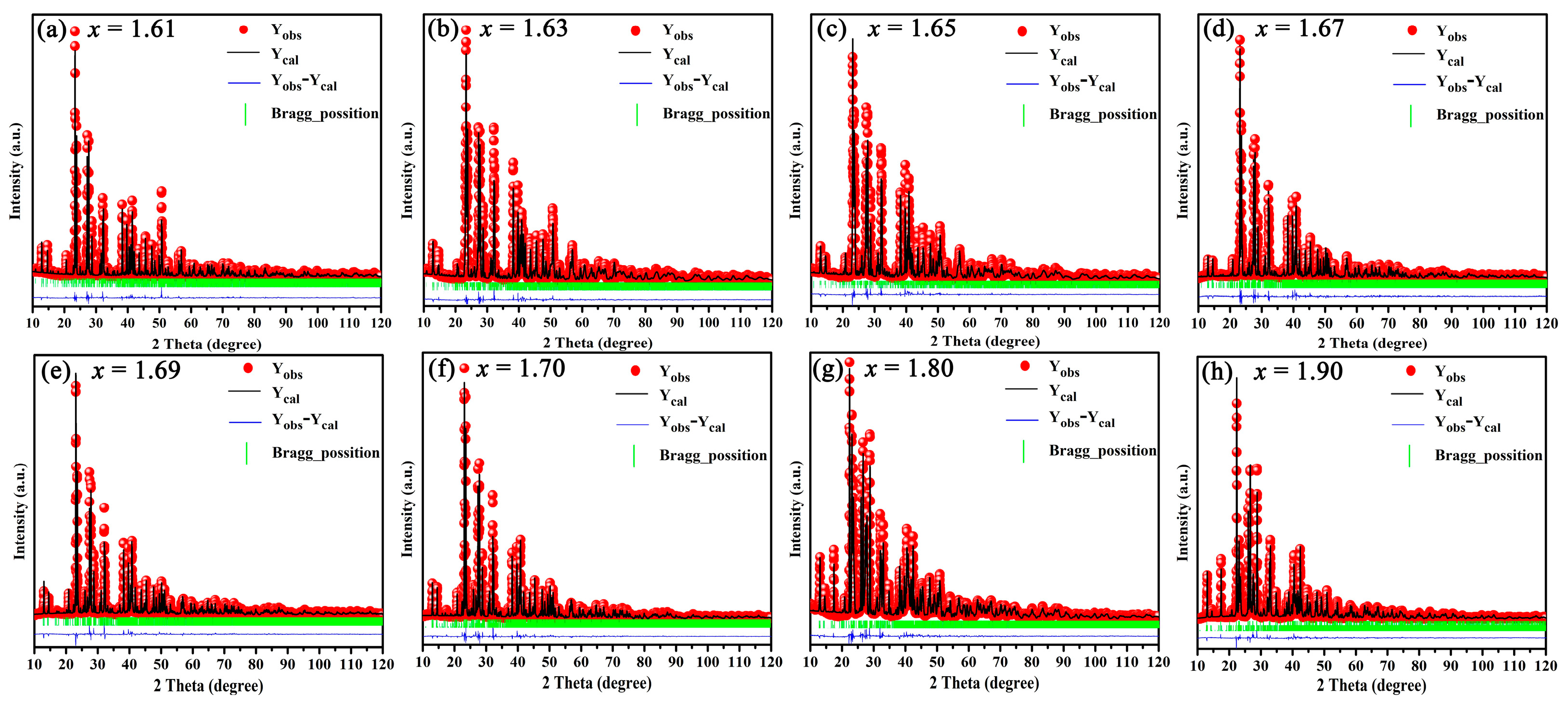
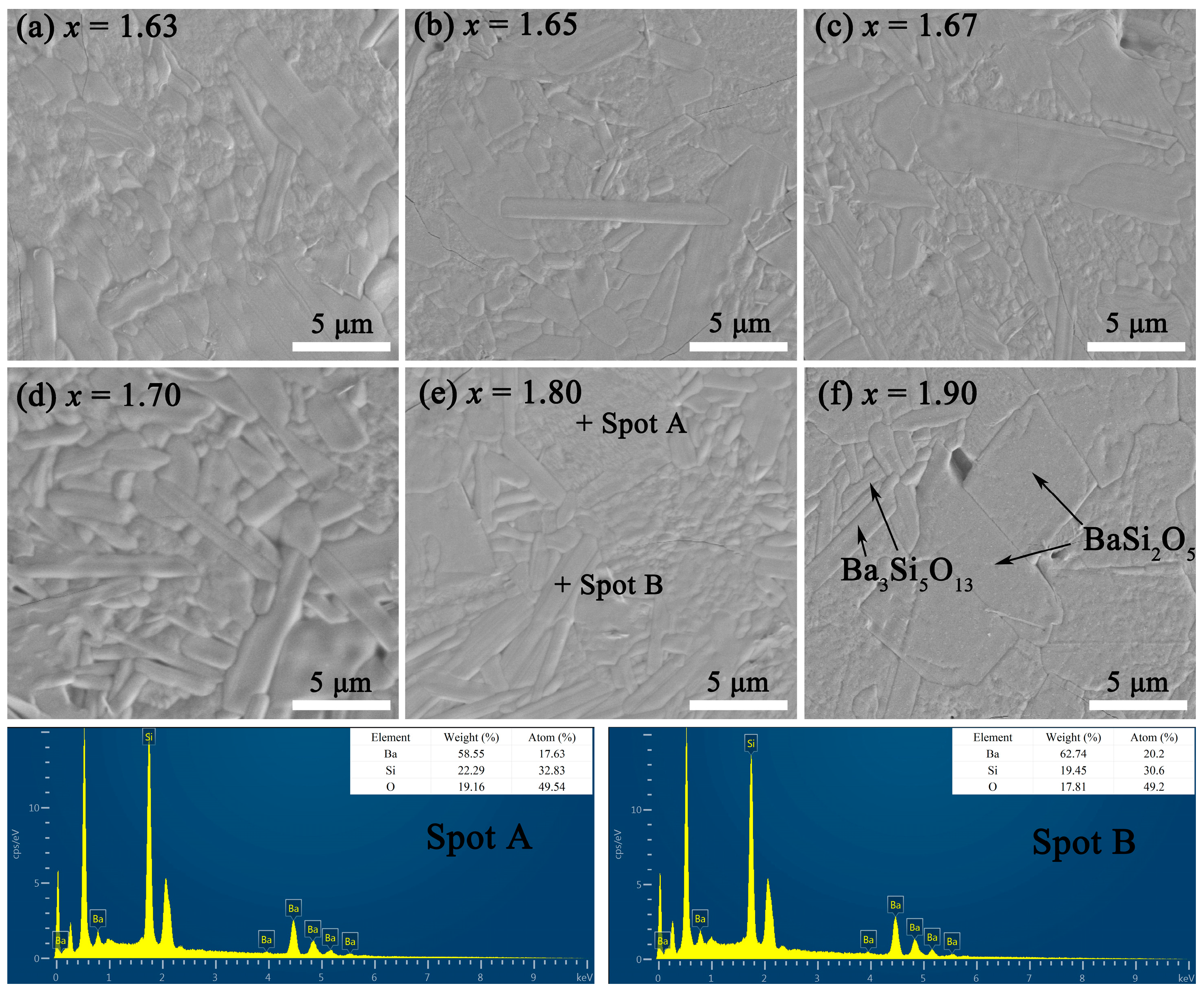

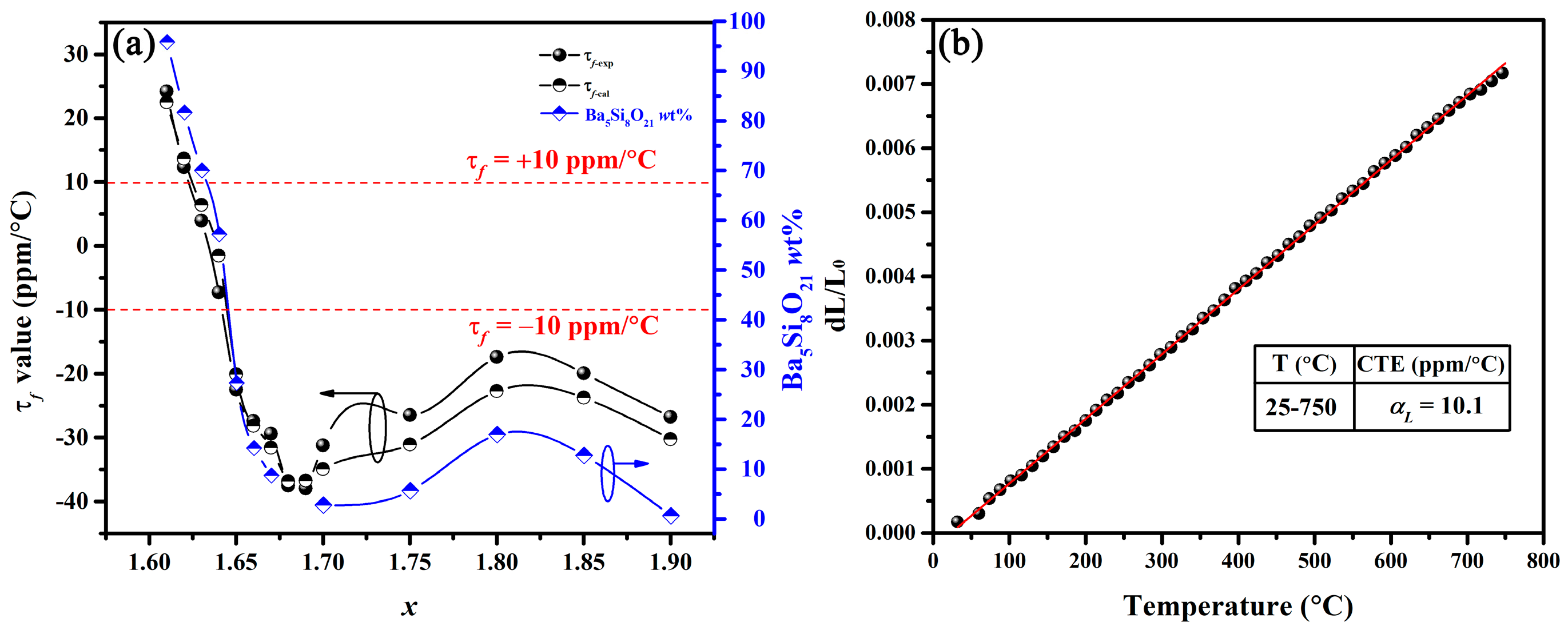
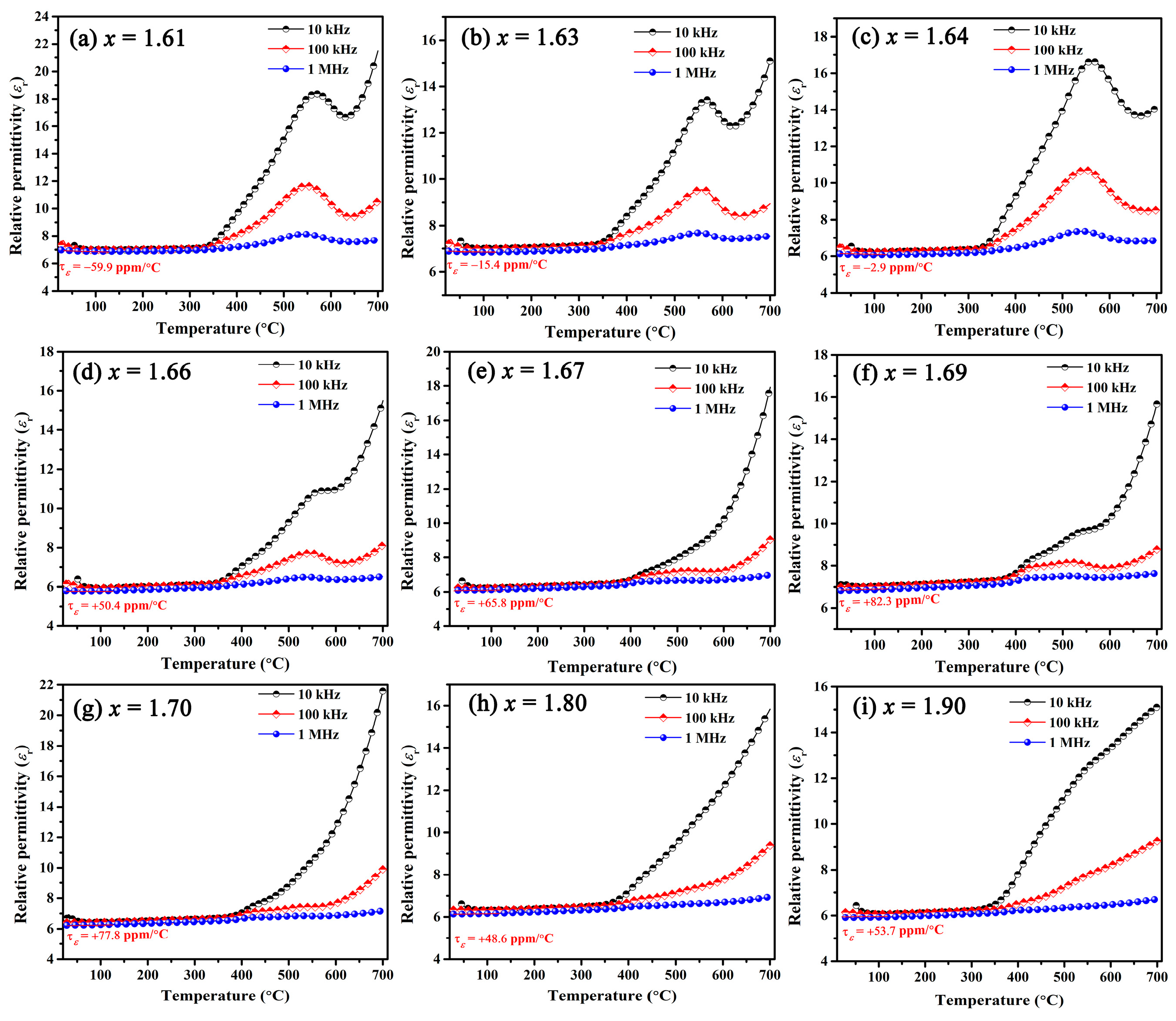
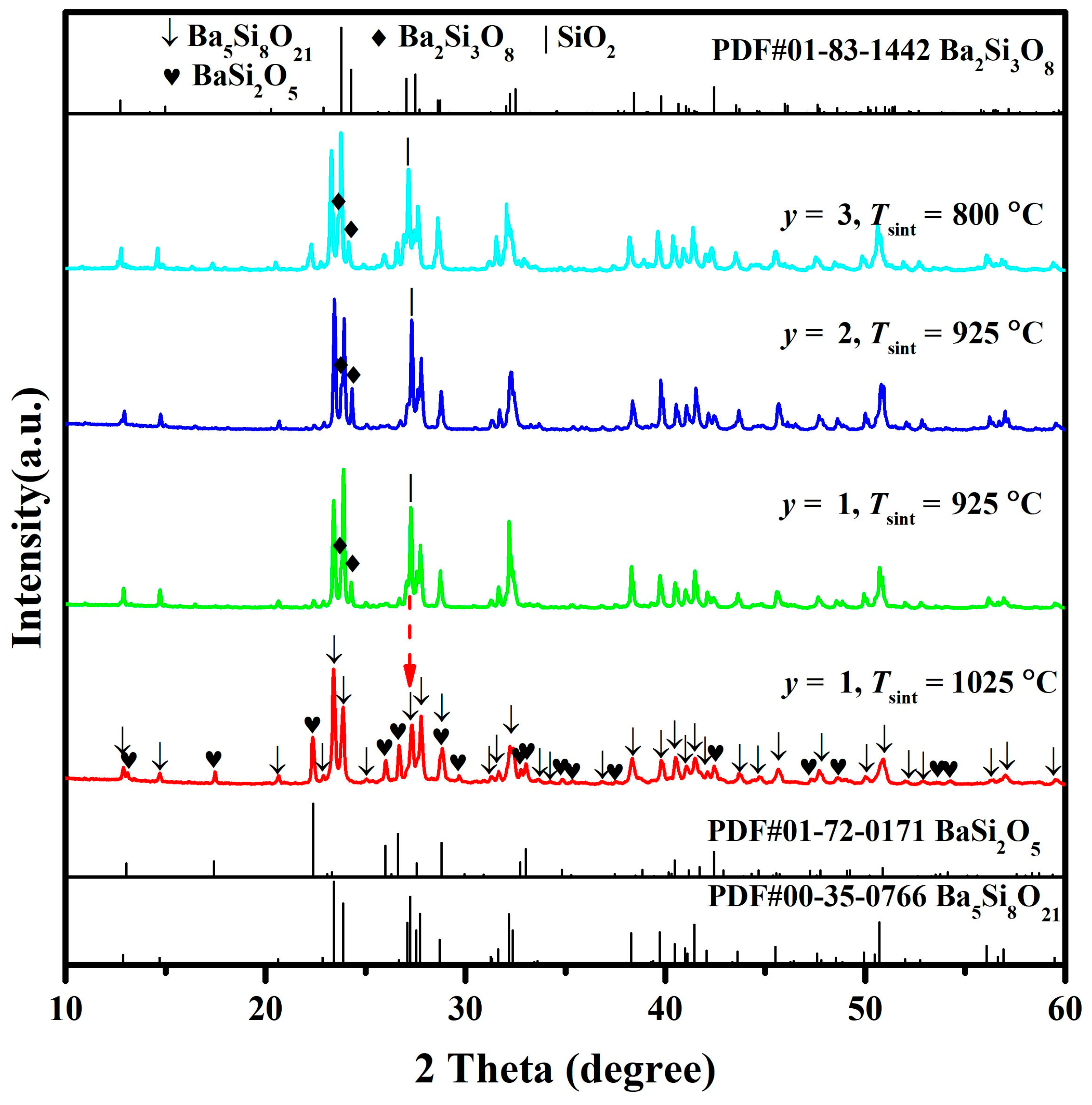
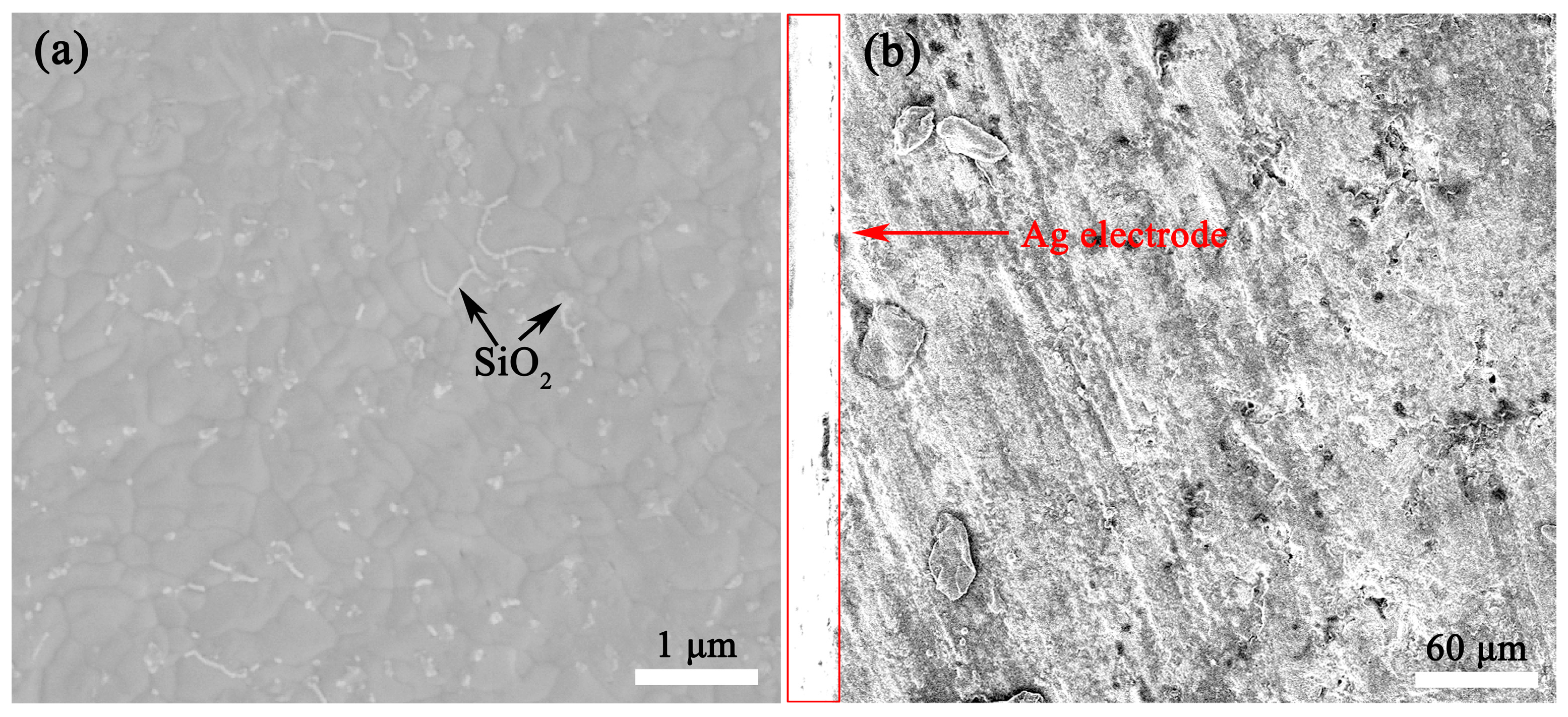
| Compositions | Phase Compositions | Lattice Parameter of Main Phase | Rietveld Discrepancy Factors | |||||||
|---|---|---|---|---|---|---|---|---|---|---|
| Main Phase (wt%) | Second Phase (wt%) | a (Å) | b (Å) | c (Å) | β (°) | V (Å3) | Rwp (%) | Rp (%) | χ2 | |
| x = 1.61 | Ba5Si8O21 (95.87) | Ba3Si5O13 (4.13) | 32.702 | 4.698 | 13.899 | 98.157 | 2113.719 | 16.2 | 12.9 | 5.8 |
| x = 1.62 | Ba5Si8O21 (81.66) | Ba3Si5O13 (18.34) | 32.723 | 4.701 | 13.892 | 98.211 | 2115.226 | 14.5 | 11.5 | 4.8 |
| x = 1.63 | Ba5Si8O21 (70.05) | Ba3Si5O13 (29.95) | 32.741 | 4.703 | 13.886 | 98.299 | 2115.890 | 16.5 | 12.8 | 6.1 |
| x = 1.64 | Ba5Si8O21 (57.21) | Ba3Si5O13 (42.79) | 32.730 | 4.701 | 13.898 | 98.189 | 2116.584 | 16.7 | 13.1 | 6.7 |
| x = 1.65 | Ba3Si5O13 (72.70) | Ba5Si8O21 (27.30) | 20.196 | 4.710 | 13.866 | 98.697 | 1303.919 | 15.7 | 12.1 | 5.3 |
| x = 1.66 | Ba3Si5O13 (85.75) | Ba5Si8O21 (14.25) | 20.199 | 4.710 | 13.858 | 98.657 | 1303.376 | 13.7 | 10.4 | 4.2 |
| x = 1.67 | Ba3Si5O13 (91.27) | Ba5Si8O21 (8.73) | 20.208 | 4.710 | 13.854 | 98.639 | 1303.641 | 13.6 | 10.8 | 3.7 |
| x = 1.68 | Ba3Si5O13 (98.15) | BaSi2O5 (1.85) | 20.213 | 4.712 | 13.856 | 98.617 | 1304.856 | 14.2 | 10.9 | 4.4 |
| x = 1.69 | Ba3Si5O13 (96.99) | BaSi2O5 (3.01) | 20.212 | 4.711 | 13.855 | 98.620 | 1304.388 | 14.0 | 10.9 | 4.0 |
| x = 1.70 | Ba3Si5O13 (92.64) | BaSi2O5 (4.68) Ba5Si8O21 (2.68) | 20.210 | 4.711 | 13.853 | 98.617 | 1304.110 | 14.5 | 11.0 | 5.0 |
| x = 1.75 | Ba3Si5O13 (67.58) | BaSi2O5 (26.83) Ba5Si8O21 (5.59) | 20.213 | 4.712 | 13.854 | 98.611 | 1304.643 | 13.7 | 10.7 | 4.9 |
| x = 1.8 | BaSi2O5 (41.79) | Ba3Si5O13 (41.34) Ba5Si8O21 (16.87) | 4.633 | 7.689 | 13.515 | — | 481.480 | 13.7 | 10.6 | 5.2 |
| x = 1.85 | BaSi2O5 (61.07) | Ba3Si5O13 (26.28) Ba5Si8O21 (12.65) | 4.634 | 7.688 | 13.524 | — | 481.766 | 14.0 | 11.0 | 5.2 |
| x = 1.9 | BaSi2O5 (71.12) | Ba3Si5O13 (28.36) Ba5Si8O21 (0.52) | 4.635 | 7.688 | 13.527 | — | 482.064 | 11.9 | 9.3 | 3.8 |
| Compositions | Phase Compositions | Lattice Parameter of Main Phase | Rietveld Discrepancy Factors | |||||||
|---|---|---|---|---|---|---|---|---|---|---|
| Main Phase (wt%) | Second Phase (wt%) | a (Å) | b (Å) | c (Å) | β (°) | V (Å3) | Rwp (%) | Rp (%) | χ2 | |
| y = 1 | Ba5Si8O21 (74.39) | BaSi2O5 (25.61) | 32.687 | 4.694 | 13.877 | 98.276 | 2106.951 | 12.0 | 9.1 | 3.9 |
| y = 2 | Ba5Si8O21 (84.51) | Ba2Si3O8 (13.14) BaSi2O5 (1.10) SiO2 (1.25) | 32.699 | 4.699 | 13.900 | 98.155 | 2114.038 | 18.3 | 14.5 | 7.6 |
| y = 3 | Ba5Si8O21 (68.69) | Ba2Si3O8 (15.55) BaSi2O5 (13.70) SiO2 (2.06) | 32.697 | 4.697 | 13.898 | 98.159 | 2112.718 | 16.0 | 12.6 | 6.5 |
| Compositions | Tsint (°C) | ρrel (%) | εr-exp | Q × f (GHz) | τf (ppm/°C) | τf-cal (ppm/°C) |
|---|---|---|---|---|---|---|
| y = 1 | 1025 | 96.5 | 7.42 | 14,252 | +8.37 | +11.00 |
| y = 2 | 950 | 95.2 | 7.21 | 12,913 | +11.90 | +16.20 |
| y = 3 | 800 | 94.4 | 7.10 | 12,463 | +5.75 | +6.12 |
Disclaimer/Publisher’s Note: The statements, opinions and data contained in all publications are solely those of the individual author(s) and contributor(s) and not of MDPI and/or the editor(s). MDPI and/or the editor(s) disclaim responsibility for any injury to people or property resulting from any ideas, methods, instructions or products referred to in the content. |
© 2023 by the authors. Licensee MDPI, Basel, Switzerland. This article is an open access article distributed under the terms and conditions of the Creative Commons Attribution (CC BY) license (https://creativecommons.org/licenses/by/4.0/).
Share and Cite
Wen, T.; Luo, Y.; Zeng, Z.; Liu, X.; Yin, C.; Cai, Y.; Li, X.; Du, K.; Lei, W.; Wang, S. Evolution of Phase Transformation on Microwave Dielectric Properties of BaSixO1+2x Ceramics and Their Temperature-Stable LTCC Materials. Crystals 2023, 13, 870. https://doi.org/10.3390/cryst13060870
Wen T, Luo Y, Zeng Z, Liu X, Yin C, Cai Y, Li X, Du K, Lei W, Wang S. Evolution of Phase Transformation on Microwave Dielectric Properties of BaSixO1+2x Ceramics and Their Temperature-Stable LTCC Materials. Crystals. 2023; 13(6):870. https://doi.org/10.3390/cryst13060870
Chicago/Turabian StyleWen, Tailai, Yulu Luo, Zehang Zeng, Xiaotian Liu, Changzhi Yin, Yiyang Cai, Xiaoxiao Li, Kang Du, Wen Lei, and Shengxiang Wang. 2023. "Evolution of Phase Transformation on Microwave Dielectric Properties of BaSixO1+2x Ceramics and Their Temperature-Stable LTCC Materials" Crystals 13, no. 6: 870. https://doi.org/10.3390/cryst13060870
APA StyleWen, T., Luo, Y., Zeng, Z., Liu, X., Yin, C., Cai, Y., Li, X., Du, K., Lei, W., & Wang, S. (2023). Evolution of Phase Transformation on Microwave Dielectric Properties of BaSixO1+2x Ceramics and Their Temperature-Stable LTCC Materials. Crystals, 13(6), 870. https://doi.org/10.3390/cryst13060870








